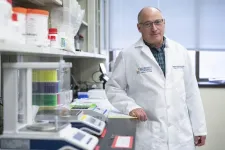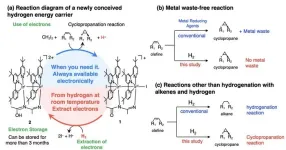(Press-News.org) There has been a redistribution in the risk of arterial disease in type 1 and 2 diabetes. The risks of heart attack and stroke have decreased significantly, while complications in more peripheral vessels have increased in relative importance, according to studies at the University of Gothenburg.
It is well known that type 1 and 2 diabetes increase the risk of heart attack and stroke. Previous research has also identified the clearest cardiometabolic risk factors in this context, such as obesity, lipid disorders, and high blood pressure.
How diabetes and cardiometabolic risk factors affect blood vessels outside central organs such as the heart and brain, in more peripheral vessels, has not been examined to such an extent. However, these risks have now been studied in two articles published in The Lancet Regional Health – Europe.
The researchers studied two decades of disease trends for virtually all peripheral arterial diseases in terms of long-term trends, control of modifiable risk factors, optimal levels for cardiometabolic risk factors, and the relative importance of selected risk factors.
Fewer complications over time
The studies include data on 34,263 individuals with type 1 diabetes and 655,250 individuals with type 2 diabetes from the Swedish National Diabetes Register between 2001 and 2020. For comparison, register data on 2,676,227 individuals without diabetes from the general population was also included.
Based on hundreds of statistical analyses, various complications in blood vessels outside the central organs have been investigated: carotid artery calcification and similar, hernia of the carotid artery, rupture of the inner wall of the carotid artery, calcification of the abdominal aorta and peripheral blood vessels in the lower extremities, and small vessel disease in the feet.
With some exceptions, these complications in type 1 and 2 diabetes have decreased over time. In relative terms, however, there has been a gradual shift in risk from arterial diseases in the central organs, such as heart attack and stroke, toward complications in peripheral vessels.
The benefits of closer checks
The results show great potential in terms of modifiable risk factors in type 1 diabetes. With closer checks on long-term blood sugar and blood pressure, the risk of several peripheral arterial complications can be reduced by 30–50%. These complications include carotid artery calcification, calcification of the abdominal aorta and peripheral vessels in the lower extremities, and small vessel disease in the feet.
However, patients with type 1 diabetes have very little to gain from lowering the current guideline values for cardiometabolic risk factors such as BMI, cholesterol and triglyceride levels, or improved renal function.
For type 2 diabetes, the analyses show that so-called bad cholesterol plays a major role in carotid artery calcification, and that lower levels of triglycerides significantly reduce the risk of peripheral arterial disease. However, being above the current guideline value for triglycerides, rather than at the guideline value, does not increase the risk.
Long-term blood sugar is crucial
In both type 1 and type 2 diabetes, long-term blood sugar appears to be by far the most important marker for peripheral arterial disease, which clearly differs from central arterial disease. At the same time, elevated long-term blood sugar appears to reinforce the aorta and significantly reduce the risk of hernia and rupture of the inner wall of the artery. The studies highlight the differences
that long-term blood sugar exerts on all blood vessels in the body, as well as important differences between central and peripheral arteries.
Aidin Rawshani is a researcher at the Department of Molecular and Clinical Medicine at the University of Gothenburg’s Sahlgrenska Academy and a resident physician in cardiology and internal medicine at Sahlgrenska University Hospital Östra, and is responsible for the studies:
“Our results reveal the potential for an even greater risk reduction for future events by maintaining lower levels of cardiometabolic risk factors, particularly early and intensive control of long-term blood sugar,” he explains. “We also noted that the relative importance of these risk factors differs between the central and peripheral arteries, revealing differences in biological effects that cardiometabolic risk factors exert in different parts of the arterial tree. Long-term blood sugar plays a much more significant role in the development of peripheral arterial disease.”
About: Disease trends 2001–2020 (number of cases per 100,000 people per year):
· Significant reduction in calcification of the carotid arteries and similar in type 1 diabetes, from 296 cases to 84. The corresponding figure for type 2 diabetes is a reduction from 170 to 84.
· Slight increase in aneurysm in type 2 diabetes, greater increase in type 1 diabetes, from 40 to 69 cases, and significant decline among control subjects without diabetes.
· Sharp reduction in calcification in the abdominal aorta and peripheral blood vessels in the lower extremities, from 723 to 311 cases in type 1 diabetes, and from 338 to 190 cases in type 2 diabetes.
· Significant reduction (the largest) in small vessel disease in the lower extremities in type 1 diabetes, from 814 to 77 cases. More modest reduction in type 2 diabetes, from 309 to 226 cases.
About: Managing risk factors (blood lipids, blood sugar, blood pressure, renal function, and lifestyle) for peripheral arterial complications:
· The risk of arterial disease in the carotid arteries and lower extremities in type 1 diabetes can be virtually eliminated with optimal control of risk factors. The risk increases fourfold (401%) with two risk factors outside therapeutic target values, and almost twentyfold (1,913%) with five risk factors, compared to controls without diabetes.
· The risk of small vessel disease in the feet in type 1 diabetes cannot be eliminated by controlling risk factors; all have between 500% and 2,944% increased risk compared to controls without diabetes.
· With type 2 diabetes and optimal risk control, there was a 16% excess risk of calcification of the abdominal aorta and peripheral arteries in the lower extremities. With two or more risk factors out of balance, the risk was 75% to 616% higher than for controls without diabetes.
· The risk of aortic complications was lower in both type 1 and type 2 diabetes, compared to controls.
Study: Non-coronary peripheral arterial complications in people with type 2 diabetes: a Swedish retrospective cohort study, https://doi.org/10.1016/j.lanepe.2024.100888 (March 2024)
Study: Non-coronary arterial outcomes in people with type 1 diabetes mellitus: a Swedish retrospective cohort study, https://doi.org/10.1016/j.lanepe.2024.100852 (February 2024)
END
Clear shift in arterial diseases in diabetes
2024-03-28
ELSE PRESS RELEASES FROM THIS DATE:
Celebrating half a century of pioneering excellence: EBMT marks its 50th anniversary
2024-03-28
Barcelona, 27 March 2024 – The EBMT proudly commemorates its 50th anniversary, marking five decades of transformative advancements in the field of hematopoietic cell transplantation (HCT) and cellular therapy. More than 5,000 healthcare professionals will gather from the 14th to the 17th of April, 2024, at the Scottish Event Campus in Glasgow for this special edition and they will immerse themselves in cutting-edge scientific content, network with their peers from across the globe, and be part of a community that is driving innovation and change.
In 1974, a small group ...
Ancient DNA reveals the appearance of a 6th century Chinese emperor
2024-03-28
What did an ancient Chinese emperor from 1,500 years ago look like? A team of researchers reconstructed the face of Chinese Emperor Wu of Northern Zhou using DNA extracted from his remains. The study, published March 28 in the journal Current Biology, suggests the emperor’s death at the age of 36 might be linked to a stroke. It also sheds light on the origin and migration patterns of a nomadic empire that once ruled parts of northeastern Asia.
Emperor Wu was a ruler of the Northern Zhou dynasty in ancient China. Under his reign from AD 560 to AD 578, Emperor Wu built a strong military and unified the northern part ...
DNA study IDs descendants of George Washington from unmarked remains, findings to aid service member IDs going back to World War II
2024-03-28
New DNA sequencing technologies have identified the historical remains of George Washington’s grandnephews, Samuel Walter Washington and George Steptoe Washington Jr., and their mother, Lucy Payne Washington, from unmarked, fragmentary bones left at the Harewood family cemetery in Charles Town, West Virginia, in the mid-1800s.
In addition to enabling the remains in question to be reunited and reburied if desired, the researchers plan to apply the validated DNA analysis techniques to their ongoing efforts to identify the remains of service members lost around the world in past conflicts going back to World War II. The findings appear March 28 in the journal iScience.
“The ...
Familial Alzheimer’s disease transferred via bone marrow transplant in mice
2024-03-28
Familial Alzheimer’s disease can be transferred via bone marrow transplant, researchers show March 28 in the journal Stem Cell Reports. When the team transplanted bone marrow stem cells from mice carrying a hereditary version of Alzheimer’s disease into normal lab mice, the recipients developed Alzheimer’s disease—and at an accelerated rate.
The study highlights the role of amyloid that originates outside of the brain in the development of Alzheimer’s disease, which changes the paradigm of Alzheimer’s from being a disease ...
Perspectives of oncologists on the ethical implications of using AI for cancer care
2024-03-28
About The Study: In this survey study of 204 oncologists, few reported that patients needed to understand artificial intelligence (AI) models, but most agreed that patients should consent to their use, and many tasked patients with choosing between physician- and AI-recommended treatment regimens. These findings suggest that the implementation of AI in oncology must include rigorous assessments of its effect on care decisions as well as decisional responsibility when problems related to AI use arise.
Authors: Gregory A. Abel, M.D., M.P.H., of the Dana-Farber Cancer Institute in Boston, is the corresponding author.
To ...
Industry payments to US physicians by specialty and product type
2024-03-28
About The Study: From 2013 to 2022, U.S. physicians received $12.1 billion from industry. More than half of physicians received at least one payment. Payments varied widely between specialties and between physicians within the same specialty. A small number of physicians received the largest amounts, often exceeding $1 million, while the median physician received much less, typically less than a hundred dollars.
Authors: Andrew J. Foy, M.D., of the Penn State Milton S. Hershey ...
Andrew E. Place, MD, PhD appointed as Dana-Farber/Boston Children’s Cancer and Blood Disorders Center Vice President, Pediatric Chief Medical Officer
2024-03-28
BOSTON -- Andrew E. Place, MD, PhD, has been named as Vice President, Pediatric Chief Medical Officer (CMO) at Dana-Farber Cancer Institute (within the Department of Pediatric Oncology) and Boston Children’s Hospital (within the Division of Hematology/Oncology) for the Dana-Farber/Boston Children’s Cancer and Blood Disorders Center.
In this role, Place will work closely with institutional and departmental leaders at Boston Children’s Hospital (BCH) and Dana-Farber to help define and implement clinical strategies and operational approaches that enhance smooth and efficient running of clinical care ...
COVID-19 antibody discovery could explain long COVID
2024-03-28
UVA Health researchers have discovered a potential explanation for some of the most perplexing mysteries of COVID-19 and long COVID. The surprising findings could lead to new treatments for the difficult acute effects of COVID-19, long COVID and possibly other viruses.
Researchers led by UVA’s Steven L. Zeichner, MD, PhD, found that COVID-19 may prompt some people’s bodies to make antibodies that act like enzymes that the body naturally uses to regulate important functions – blood pressure, for example. Related enzymes also regulate ...
Wild plants face viral surprise
2024-03-28
Just as many people battle seasonal colds and flu, native plants face their own viral threats. People have long known that plants can succumb to viruses just like humans. Now, a new study led by Michigan State University and the University of California, Riverside reveals a previously unknown threat: non-native crop viruses are infecting and jeopardizing the health of wild desert plants.
“For years, the ecological field assumed wild plants were immune to invasive viruses that damage crops,” said Carolyn ...
Storing electrons from hydrogen for clean chemical reactions
2024-03-28
Fukuoka, Japan—Researchers from Kyushu University have developed a hydrogen energy carrier to address some of the biggest hurdles in the path towards a sustainable hydrogen economy. As explained in a paper published in JACS Au, this novel compound can efficiently “store electrons” from hydrogen in a solid state to use in chemical reactions later.
Hydrogen is a promising source of clean energy with a lot of untapped potential applications in industry and everyday life. Unlike conventional fuels, hydrogen can be used to generate electricity without producing greenhouse ...





